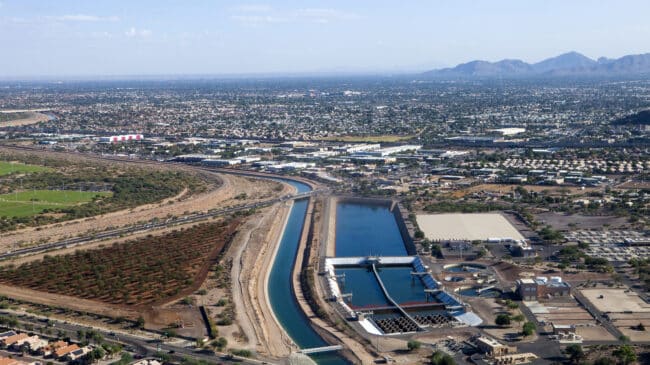Arizona has long enjoyed extensive economic and population growth, but this year’s federal designation of a Tier 1 shortage restricting the state’s share of Colorado River water and restricting water supply to Central Arizona agricultural users presents a stark reminder of the need for major ongoing investments in public water infrastructure to sustain a strong economic future.
With the state’s elected leaders prudently setting aside more than $500 million for water augmentation and conservation projects and overhauling the state agency responsible for financing water infrastructure in the closing days of the legislative session, Arizona’s robust tradition of using public-private partnerships (P3s) to deliver critical water investments appears set to enter a transformative new phase.
The state’s economy today would not exist without the legacy of major waterworks like the Central Arizona Project or Salt River Project’s network of dams, reservoirs, and canals—projects built with extensive collaboration between federal, state, and private entities. Cities like Phoenix have also used public-private partnerships to deliver major new water and wastewater infrastructure.
Financing water infrastructure is complex, but the fundamental issue for Arizona is simple: There aren’t enough traditional tax or ratepayer dollars today to deliver the future water infrastructure Arizona needs.
Offshore desalination plants, new reservoirs, and multistate pipeline agreements are among the types of promising—but costly—new-build water supply projects that have captured the minds of policymakers.
These projects could easily cost billions of dollars on their own and, back in 2013, the U.S. Environmental Protection Agency estimated the state would need $7.4 billion by the mid-2030s just to improve, repair, and upgrade existing water infrastructure, a figure that excludes costly expansions needed to accommodate population growth.
Public-private partnerships provide opportunities to overcome many of the water infrastructure challenges that Arizona faces, including sourcing, conveyance, and treatment. They have been used extensively around the world to ensure water systems and treatment facilities are financed, built, operated, and upgraded in ways that minimize taxpayer exposure.
When government water agencies enter partnerships designed to manage major financial and operational risks, they shield taxpayers and users from unexpected repairs and other costly problems.
While water P3s typically involve large projects with high upfront costs, they also include decades-long commitments to operations and maintenance that government agencies typically lack the resources to do alone, resulting in lower operating costs over the long term.
Private partners are on the hook for decades for managing the systems under performance-based contracts, as well as handing managed assets back to government owners in good shape. Contracts designed to protect the public interest while outlining clear terms for project delivery give partner firms the incentive to find value through the right capital investments that balance cost and quality.
Some major P3 investments are being used to secure and deliver water from new sources to accommodate population growth. In 2016, fast-growing San Antonio, Texas, entered a 30-year, $923 million P3 to deliver up to 50,000 acre-feet of water per year via a new 140-mile pipeline to provide about half of the water needed to meet future population demand.
The partnership puts the risks of securing the water on the private partner responsible for negotiating with local landowners to secure drinking water supplies, as well as the risk of building and operating a 140-mile pipeline to deliver the water to the city from its watershed source. The project was financed with loans taken out by the private partner, which will be repaid by the city over several decades from collected user fees.
Santa Clara, California, after an unsuccessful attempt a few years back, is close to finalizing a similar 30-year, $600 million public-private partnership that would secure water from multiple sources.
Just as Arizona’s water challenges aren’t confined to sourcing clean water, P3s can be and have been used to overcome numerous ecological and environmental challenges. Chicago, Atlanta, Baltimore, and many large cities have partnered with private firms to deliver and operate wastewater treatment and processing facilities to help prevent massive pollution problems, often to comply with EPA and state consent decrees.
Opportunities also exist to encourage land ownership practices through P3s that reduce the strain put on water and sewer infrastructure: Prince George’s County in Maryland has worked with landowners and developers to integrate more porous ground surfaces capable of diverting stormwater from the area’s overburdened sewer systems. And San Mateo, California, is in the process of exploring an advanced water treatment P3 that can keep clean water in reserve for droughts and other hazardous conditions.
Innovations in leak detection, a problem that results in 1.7 trillion gallons worth of lost revenue for water systems each year, are also becoming a source of water agency contracting, as technology allows detection using acoustics without digging.
With the Arizona state legislature setting aside a major down payment for critical water projects and simultaneously expanding the state finance agency’s toolkit to deliver them the key to success will be giving governments the greatest flexibility to enter long-term public-private partnerships designed to increase water supplies through acquisition, treatment, conservation and more.
Arizona’s continued economic success will require effective partnerships between public, private, and stakeholder interests to secure the state’s clean water future in a fiscally responsible way going forward.
A version of this commentary first appeared in The Arizona Republic.


